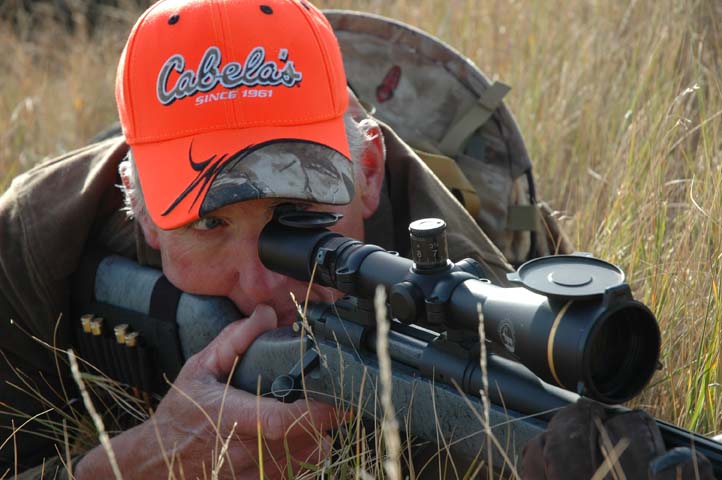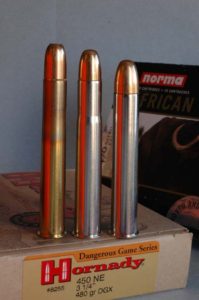

Launching a bullet sends a surge of energy in the opposite direction. We feel it as recoil. Boost bullet speed or weight, and recoil increases. Adding weight to a rifle reduces felt recoil because the mass absorbs the thrust.
But shooting position also affects what you feel. If your body is free to “give” under recoil, it will hurt less. Stock dimensions matter too. A low, sharp comb can bang you mercilessly. A short length of pull gives the rifle a running start. A grip and forend that afford your hands little purchase let the rifle come back fast. A small, hard buttplate focuses and accentuates the thrust.

Uncomfortable recoil makes you flinch. Flinching makes you miss. No matter how big and tough you are, lively recoil gets your attention. If you’re thinking about recoil or anticipating the rifle’s kick, how can you focus on smooth execution of a shot? You can’t.
Muzzle brakes mitigate recoil by bleeding gas through ports to the side as the bullet exits. But the noise and blast of a braked rifle can affect you as severely as the recoil. Without adequate ear protection, you’ll sacrifice your hearing to muzzle brakes. At the range, ear-plugs and muffs (I use both) make brakes practical. In the field, you’ll want to pick up slight noises. Solution: install a brake for routine practice, then replace it with a cap to cover the muzzle threads when you hunt. You’ll probably not notice recoil when firing one shot at game.
Because felt recoil varies from rifle to rifle, and load to load, ranking cartridges by recoil energy is pointless. But you can easily determine the recoil thrust of your pet loads in your rifle:
KE=MV2/GC, where M is the rifle’s mass and V is its velocity. GC is a gravitational constant for earth: 64.32. V= bullet weight (grs.)/7000 x bullet velocity (fps) + powder weight (grs.)/7000 x gas velocity (fps)/M.

Powder and gas figure in because as “ejecta” they contribute to recoil. Gas speed varies, but Art Alphin, in his A-Square loading manual, suggests 5200 fps as an average. The “7000” denominators convert grains to pounds so units make sense in the end.
For a 180-grain bullet fired with a 70-grain powder charge at 3000 fps from an 8 ½-pound .300 Magnum, the numbers line up like this:
180/7000 x 3000 + 70/7000 x 5200 = 8.5 x V. Simplified: (77.143 + 52)/8.5 = V = 15.19 fps.
The final formula: 8.5(15.19)2/64.32 = 30.49 ft.-lbs. of recoil.
If math either bores you or triggers high-school nightmares, you can scrounge recoil figures from tables, available from a variety of sources for common rifles and cartridges.
Some loads are unconscionably brutal. The .378 Weatherby hammers you with 90 ft.-lbs. that feel like a whack from a splitting maul. Lightweight rifles can be vicious, even with proper stocking. My 7 ½-pound .458 leaves cheek and clavicle begging for mercy. A 9-pound .30-06 delivers a civil 19 ft.-lbs. of recoil with a 180-grain bullet. A 7-pound ’06 hits you with 25 – about as much as a 150-grain load in a 9-pound .300 Winchester.
To shoot well, use a rifle that doesn’t beat you up. There’s no glory in fighting recoil, or missing because you flinch.

Next Step: Get your FREE Printable Target Pack
Enhance your shooting precision with our 62 MOA Targets, perfect for rifles and handguns. Crafted in collaboration with Storm Tactical for accuracy and versatility.
Subscribe to the Gun Digest email newsletter and get your downloadable target pack sent straight to your inbox. Stay updated with the latest firearms info in the industry.

![Best Concealed Carry Guns In 2025 [Field Tested] Wilson Combat EDC X9S 1](https://gundigest.com/wp-content/uploads/Wilson-Combat-EDC-X9S-1-324x160.jpg)


![Best 9mm Carbine: Affordable PCCs [Tested] Ruger Carbine Shooting](https://gundigest.com/wp-content/uploads/Ruger-Carbine-Shooting-100x70.jpg)
![Best AR-15: Top Options Available Today [Field Tested] Harrington and Richardson PSA XM177E2 feature](https://gundigest.com/wp-content/uploads/Harrington-and-Richardson-PSA-XM177E2-feature-100x70.jpg)

If you sight in with a brake, and then swap out the brake for a thread-saver, you will likely find your bullets aren’t hitting your point of aim anymore. The brakes will effect the barrel harmonics, which can move bullets more than most people would think. Also, a load tuned to shoot well with a brake, may not shoot the same small groups without a brake installed.